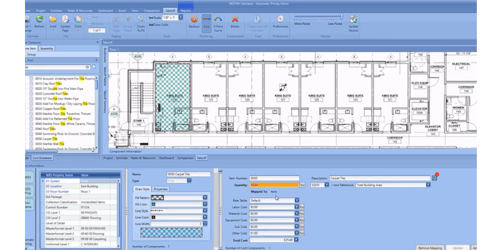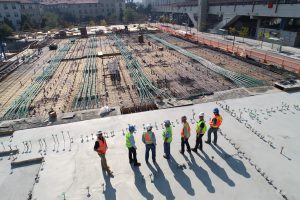5 Tips to Keep Your Estimators Happy
Struggling with High Turnover on Your Team?
Team morale. Employee retention rate. Labor shortage. These are all terms you’ve heard tossed around a lot lately, especially as trends change and job seekers have started to place higher expectations on the companies they’re applying to. More and more people are realizing that if they aren’t happy and fulfilled somewhere, they don’t have to stick around. In a world where senior preconstruction talent is becoming harder to find, you don’t want to lose your best estimators.

It’s up to general contractors to create cultures that make their employees want to stay year after year. However, that’s a lot easier said than done. Many companies turn to flashy gimmicks instead of substantial change to draw in prospects. They might adopt new technology that doesn’t align with their mission and brand but has some cool flashy features, or they might install a company café for lunches and post-work happy hours. Employees, both current and potential, are going to see right through these kinds of actions.
When people are deciding where they want to cement their careers, they’re looking for a company that is willing to embrace thoughtful, strategic change; that offers them opportunities to grow their careers, and that has a proven track record of innovation within the industry.
But at the end of the day, everything we just said is just as buzz wordy as the words we shared in the first paragraph. What does strategic change, opportunity, and innovation look like in the everyday work week? What does it take to keep your estimators happy at your company?
So, what are estimators looking for?
To find out, we spoke to Brent Pilgrim, who has been with The Beck Group for 21 years and currently serves as their National Director of Preconstruction, and Jan Beran, who spent 11 years as an estimator before moving to Senior Implementation Specialist at Beck Technology. Thanks to their input, we’ve compiled five strategies to keep your precon team from leaving.
- Pay your estimators and pay them well.
- Be sure that you're offering them the chance to cross-train.
- Invest wisely in construction estimating software.
- Have consistent, frequent check-ins where you provide both constructive and positive feedback.
- Define your vision and live it out.

Pay Your Estimators Well
This goes without saying, but it’s important to remember that the majority of people don’t work from the kindness of their heart. They work to live! Feelings of accomplishment and pride in one’s work are not enough to sustain someone in the real world, and the best way to recognize your employees—particularly those with a specialized skill set—is by paying them, and not just paying them the bare minimum you can get away with, but the amount they truly deserve for their time and skills.
Jan says, “Estimators need technical smarts, technology smarts, people smarts, and even a ‘good enough to be dangerous’ amount of building smarts. That’s a lot of different types of smarts. Pay them like it. Estimating/preconstruction should have one of the widest pay arcs in the company.” If you’re trying to develop high-level, experienced estimators who will take on senior roles at your company, then your employees’ salaries should match your high expectations.
Offer Cross Training Opportunities
 On the flip side of the coin, money alone is not enough to create a truly fulfilled employee. We’ve all heard of people quitting their six-figure jobs because they felt stagnant, stressed, and burned out. Employees need to feel free to explore different passions and interests.
On the flip side of the coin, money alone is not enough to create a truly fulfilled employee. We’ve all heard of people quitting their six-figure jobs because they felt stagnant, stressed, and burned out. Employees need to feel free to explore different passions and interests.
This is what happened to Brent in his role at The Beck Group. Company leadership supported him in pursuing different avenues of interest in his career. In between serving different roles within The Beck Group, Brent worked with Beck Architecture on how a project goes from concept design to construction documents and launched a task force under the BIMForum that is dedicated to “changing the way the industry views and practices model-based estimating.” But he wouldn’t have been able to do these things without support from The Beck Group and their passion for getting him involved in different opportunities, many of which involved cross-training in a variety of departments.
As Brent puts it: “These various cross-training opportunities were important to my story, and why I have been so happy at Beck. To this day, I consider cross-training to be one of the most under-valued experiences we can ask our employees to go through. Some of this was by accident, some of it was more intentional. Through intentional conversations with leadership about what I was interested in, what I wanted to do, pursue, and become. I consider myself a life-long learner, curious and interested in different things.”
Invest Wisely in Construction Estimating Software

Part of opening your employees to a variety of interesting opportunities also means making wise investments in preconstruction software. Employees aren’t going to be excited by using outdated programs and decades-old methods when there are many superior alternatives available on the market.
You want to carefully evaluate any construction estimating software that you consider purchasing and ensure that the vendor behind them aligns with your values. And you also want to make sure that you’re involving your employees in this process.
Part of Brent’s journey at The Beck Group involved getting to experience software like DESTINI Profiler and DESTINI Estimator, and it played a huge role in his desire to continue growing his career at Beck. “In the 2005-2006 timeframe, I learned about Beck Technology, and became a superuser of DProfiler,” he said. “I took to this role very naturally for some reason and I had a lot of fun in this role. In a sense, being a Profiler superuser was like being an IPL on the front end of a project. As a superuser, we had to understand design concepts to create a 3D model of a project from nothing but a program. We had to understand the cost and schedule impacts of various construction systems and design decisions. And of course, we had to be technically competent and agile with the software.”
Provide Construction and Positive Feedback Regularly
Payment, exciting opportunities, and experimenting with construction estimating software are all well and good, but it’s equally as important to provide your employees with consistent feedback that focuses on what they can improve and what they’ve done well. When employees don’t get any kind of feedback, that leaves them in the dark about their path and where they can expect to go next. And when they only receive constructive/negative feedback, they can quickly feel defeated and hopeless.

Jan says there are two areas in which employers can really shine. First, he says they need to have “frequent strengths-based check-ins on near term future work. These check-ins are not performance appraisals. They are as often as necessary, typically every week for the first two-three years and then you can adapt after that. The employee comes with their list of what they’re working on, and the manager comes with the attitude and opening question of, ‘what are you working on and how can I help?’” He adds, “Find out how the employee feels their contributions matter and double your intent to catch them doing well.”
Define Your Vision and Live it Out
Last but certainly not least: your employees aren’t going to want to stay at your company if you don’t even know why your company exists. Of course, the purpose of every business is to generate profit. But no successful business is going to last if that’s the sum of their vision for the future. You need to clearly define what your vision is—whether that’s changing the world of healthcare construction or innovating in data visualization—and then you need to actually live it throughout your entire preconstruction efforts.
The Beck Group’s clear and vibrant vision for their future endeavors was what initially drew Brent to working for them as a young graduate straight out of college. “I came to Beck because I bought into the vision that Peter Beck was selling,” said Brent. “I knew I wanted to be involved in a company that was doing ‘true’ design-build, which to me was integration, meaning they had in-house design/architecture and in-house construction—it wasn’t a marriage by contract of two separate companies.”
Brent was able to look at what the Beck Group was currently doing at the time he applied for a job there, and their track record showed him that they weren’t just talking about their vision, they were actively taking steps to make it happen. Asking yourself the question “who are we, and why do we do what we do?” can help you solidify your mission and core values, as well as demonstrate to your employees that you’re serious about not stagnating.
What tips will you use?
We hope these five tips help you kickstart your journey to improving your talent retention and building up your junior estimators to become senior estimators. And if you’re interested in learning even more about how you can utilize tip #3, get in touch with us today by scheduling a demo of DESTINI Estimator by clicking the button below.

-1.png?width=112&height=112&name=image%20(4)-1.png)















